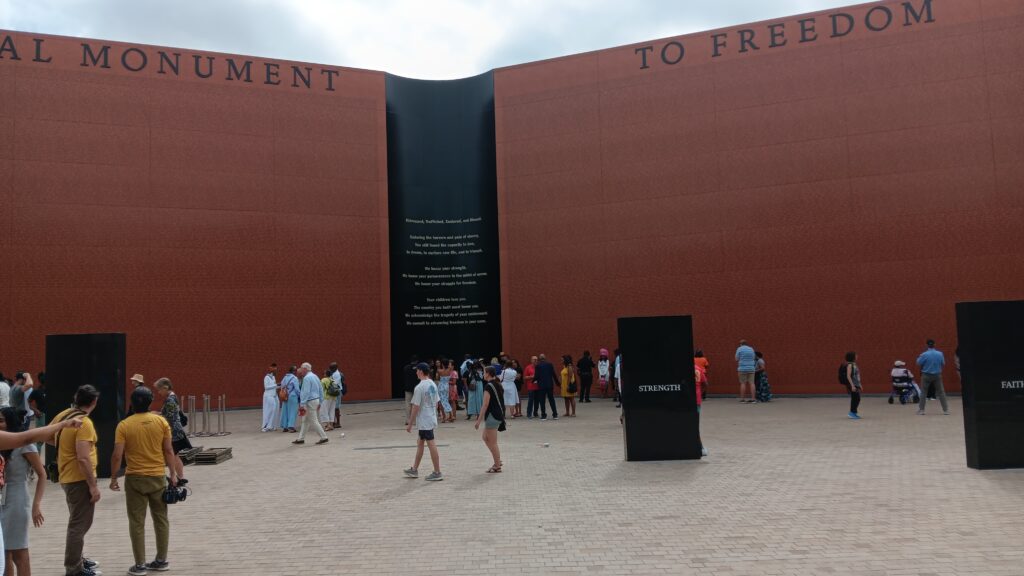The National Monument to Freedom serves as the focus of a private dedication for the Equal Justice Initiative on June 19, 2024. (Ralph Chapoco/Alabama Reflector)
People who visit the Freedom Monument Sculpture Park in Montgomery, Alabama, will not only face the brutality of slavery and the hardship it caused.
They will also encounter the grace and love the people who were enslaved demonstrated amid their struggles.
More than 200 people gathered at the park on Wednesday to dedicate the National Monument to Freedom, a wall nearly 50 feet high and more than 150 feet long that embodies the struggle of slavery. Inscribed in it are the 122,000 surnames that represent millions of Black families considered property before the county ended slavery and formally recognized them as human beings.
Bryan Stevenson | Photo by Ted Vaden
“I am really emotional this morning,” said Bryan Stevenson, the executive director of the Equal Justice Initiative, which created the park, in an interview after the ceremony at the wall. “We have been working a long time to create a space that honestly and appropriately honors the 10 million people who were enslaved in this country. I really think it is important that we reckon more honestly with the history of slavery and the legacy that it creates.”
The monument, dedicated on Juneteenth, aims to create a counter narrative to the story people typically encounter when learning about the history of racism and slavery in the United States.
“Enslaved people resisted,” Stevenson told the crowd that gathered for the dedication. “Enslaved people were resilient. Enslaved people found ways to labor a way out of no way. Enslaved people learned to sing. They sang songs of freedom, songs of hope, songs of hope, songs of truth, songs of grace, and it was those songs that allowed them to endure.”
The dedication also included performances from trumpeter and composer Wynton Marsalis; New York Philharmonic clarinetist Anthony McGill and the Jason Max Ferdinand Singers.
The wall rises at the end of the end of a trail that takes the visitor through the nation’s history, starting with sculptures focusing on Native Americans;the transatlantic slave trade and the domestic slave trade.
The grounds also include a rail car and dwellings of people who were enslaved to give them a sense of the environment and hardship that slaves dealt with throughout their lives.
The park includes other works of art with words of former slaves who placed advertisements hoping to find loved ones who were sold away.
The wall, at the end of the trail, features the surnames of former slaves recorded in the 1870 Census, the first one to recognize those who were freed from bondage. Technology allows visitors to find the location of a specific last name, as well as select different counties within the U.S. and find the names of former slaves who lived there.
A sculpture at Freedom Monument Sculpture Park in Montgomery, Alabama showing the faces of the enslaved. The park depicts the brutality of American slavery and the lives of those in it. (Equal Justice Initiative/Human Pictures)
For Stevenson, the wall and the supporting technology offer a more comprehensive understanding of the institution of slavery. It was oppressive and abusive, but it also forged people who had the strength to endure the hardship to create families and form bonds to serve future generations.
The park is the latest site founded by EJI memorializing victims of racial oppression in the United States. It complements other sites founded by EJI in Montgomery, including the National Memorial for Peace and Justice and the Legacy Museum, which honor lynching victims and offer a glimpse into racial violence and terror.
Montgomery was a hub of the domestic slave trade in the antebellum period. In 1860, 23,710 people in the county — 66% of the population — were enslaved. According to EJI, at least 12 people were lynched in Montgomery between 1877 and 1950. But the Black community in Montgomery had a long history of resistance, from challenges to Alabama’s Jim Crow constitution to the Montgomery Bus Boycott.
“The people on this wall are the most important people that have been in this country, that shaped this country,” said Darron Patterson from Mobile, one of the guests of the dedication. “They taught us how to live, to make a way out of no way. And that is what we are doing now.”
Another guest, Lou Seawright, who lives in Greenville, Indiana said the wall is a reminder of the struggle that she, as a Black person, has endured.
“We are the fabric of America,” she said. “This is necessary. We have had conversations, and in those conversations, we have heard people say we need to have dialogue, talk about the narrative. Now we need to move beyond talking—and this is the point where we move beyond talking and move into action.”
GET THE MORNING HEADLINES DELIVERED TO YOUR INBOX
This story originally appeared in the Alabama Reflector.
Alabama Reflector is part of States Newsroom, a nonprofit news network supported by grants and a coalition of donors as a 501c(3) public charity. Alabama Reflector maintains editorial independence. Contact Editor Brian Lyman for questions: info@alabamareflector.com. Follow Alabama Reflector on Facebook and X.
The post Equal Justice Initiative dedicates monument to slavery survivors at Montgomery memorial park appeared first on Wisconsin Examiner.

